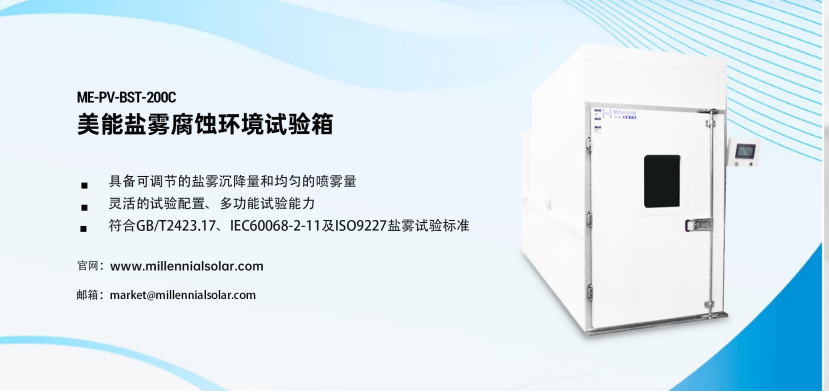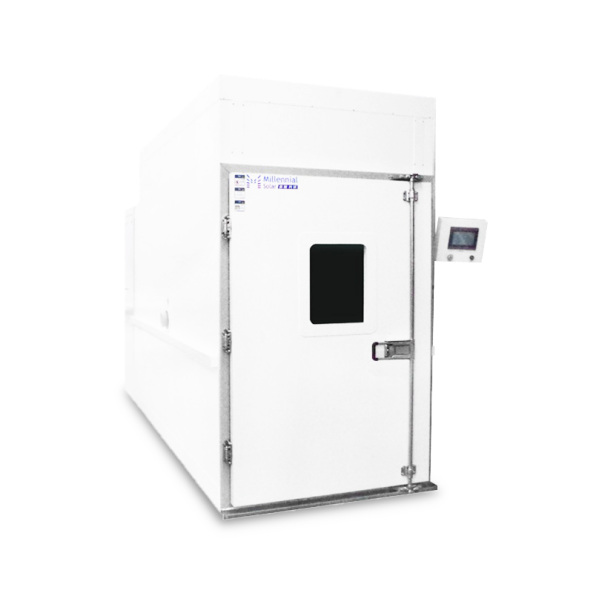
量子效率测试仪
PL/EL一体机
Sinton硅片少子寿命测试仪
Sinton硅块少子寿命测试仪
绒面反射率测试仪
3D共聚焦显微镜
清洗制绒工作站
在线四探针方阻测试仪
全自动扫描四探针方阻测试仪
在线薄膜厚度测试仪
晶化率测试仪
Horiba显微共焦拉曼光谱仪
傅里叶红外光谱仪
霍尔效应测试仪
分光光度计
全光谱椭偏仪
Horiba椭圆偏振光谱仪
TLM接触电阻率测试仪
超景深显微镜
网版智能影像测量仪
全自动影像测量仪
卧式拉力机
电池片稳态光衰老化试验箱
电池片紫外老化试验箱
电池片拉脱力综合测试仪
外观检验台
湿漏电测试系统
组件实验室EL测试仪
紫外老化试验箱
稳态光衰老化试验箱
电流连续性监测系统
PID测试系统
旁路二极管测试系统
LeTID测试系统
反向电流过载系统
脉冲电压测试系统
绝缘耐压测试仪
接地连续性测试仪
绝缘耐压接地测试仪
湿热环境试验箱
湿冻环境试验箱
热循环试验箱
动态机械载荷测试机
静态机械载荷测试机
冰雹冲击试验机
引出端强度试验机
霰弹冲击试验机
抗划伤(切割)测试机
剥离试验机
万能材料试验机(单臂)
万能材料试验机(双臂)
光伏玻璃透过率测试仪
醋酸测试试验箱
交联度测试系统
二极管接线盒综合测试仪
落球冲击试验机
半自动四探针
全自动探针式台阶仪
多通道太阳能MPPT系统
Horiba稳瞬态荧光光谱仪
钙钛矿P1激光划线测试仪
钙钛矿在线膜厚测试仪
钙钛矿工艺检测工作站
手持式IV测试仪
便携式EL测试仪
手持热成像测试仪
户外组件IV测试仪
户外组件多通道测试系统
光伏逆变器电能质量测试仪
无人机EL检测仪
优化耐腐蚀材料测试:美能盐雾腐蚀试验箱的应用
日期:2024-07-02浏览量:10
在探索材料在海洋性气候中的耐腐蚀性能时评估材料耐腐蚀性的关键工具之一是盐雾腐蚀试验。美能盐雾腐蚀试验箱凭借先进技术和严格遵循GB/T10587及ISO 9227标准,为测试提供高效准确的环境模拟。该设备使用耐腐蚀材料制成,具备气动开启、可调喷雾量和自由沉降雾粒等特点,确保了测试的精确和重复性。此外,触摸屏温度控制和声光报警装置增强了操作的便利性和安全性,使其成为电工设备和金属材料测试的理想选择。

人工模拟海洋性气候的盐雾腐蚀试验
人工模拟海洋性气候的盐雾腐蚀试验是一种用于评估材料在海洋环境中耐腐蚀性能的重要方法。通过这些试验,可以模拟海洋大气环境中的腐蚀过程,从而预测材料在实际海洋环境中的使用寿命和可靠性。
不同的材料和合金在模拟海洋大气环境下的腐蚀行为表现出显著差异。例如,Sn-0.7Cu合金在添加微量元素Ga后,其抗盐雾腐蚀性能得到了显著提高,这主要归因于Ga在表面形成的致密保护性氧化膜。此外,1050A铝合金在模拟海洋大气环境中的腐蚀行为研究表明,随着腐蚀的不断进行,腐蚀产物不断增多,失重增加,阻抗值逐渐减小。镀锌钢在模拟海洋大气环境下的腐蚀行为研究也显示了耐蚀性的变化趋势。


盐雾试验后的表面腐蚀形貌
人工模拟海洋性气候的盐雾腐蚀试验是评估材料在海洋环境中耐腐蚀性能的有效方法。通过这些试验,可以详细了解材料在模拟海洋大气环境下的腐蚀行为和机理,从而为材料的选择和改进提供科学依据。同时,通过优化试验装置和方法,可以进一步提高试验的效率和准确性。
ISO 9227标准是国际标准化组织(ISO)制定的关于盐雾试验的标准,主要用于评估材料在盐雾环境中的耐腐蚀性。
测试溶液:通常ISO 9227标准会规定使用一定浓度的氯化钠溶液作为测试介质,以模拟海洋环境中的盐雾条件。
测试装置:根据证据,CASS试验(连续喷雾盐雾试验)是一种常见的测试方法,其中使用特定尺寸和厚度的CR4级钢制参考样品进行测试。这些样品应具有基本上无瑕疵的表面和亚光面漆,以确保测试结果的准确性。

美能盐雾腐蚀试验箱,可对电工设备、金属材料与制品的镀、涂层等进行加速腐蚀性能变化试验。产品设计不仅生产执行国家GB/T10587《盐雾试验箱技术条件》,也可按照ISO9227《人工模拟气候腐蚀试验--盐雾试验》等标准进行相关的盐雾试验。
美能盐雾腐蚀试验箱

联系:400-008-6690
●箱体采用耐腐蚀材料制作,气动式开启方式
● 盐雾沉降量可调、喷雾量均匀,雾粒经设计可实现,自由沉降
● 温度控制采用触摸屏仪表,控制喷雾时间
●设备具有声、光报警装置及超温保护装置
美能盐雾腐蚀试验箱以其高级技术和一致性遵循国际与国内标准,为材料科学研究和工业应用提供了一个精确和可靠的测试平台。它的设计细节和增强功能不仅确保了测试过程的高效性和准确性,还通过先进的安全特性提供了用户友好的操作体验。




































































